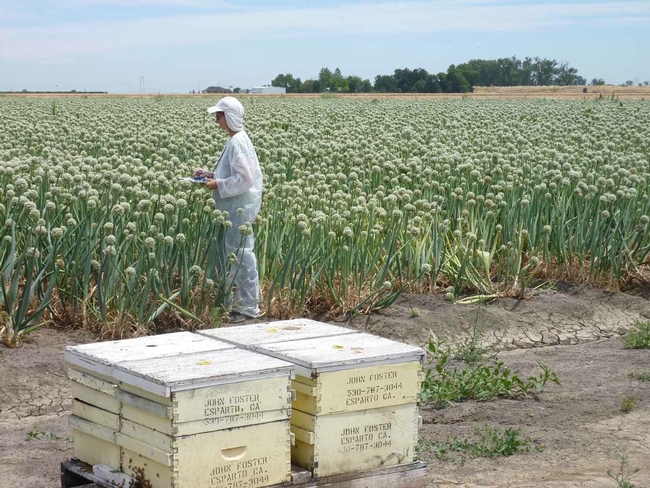A lack of pollination by honey bees — brought on by increased insecticide use to control onion thrips — was linked to a sharp decrease in yields of California onion seeds, according to research published in the July-September 2011 issue of the University of California’s California Agriculture journal.
“Honey bee visits to onion flowers were negatively correlated with the number of insecticides applied per field and field size,” wrote the study’s authors, Rachael F. Long of UC Cooperative Extension in Yolo County and Lora Morandin of the Department of Environmental Science, Policy and Management at UC Berkeley. “Reduced onion seed yields in recent years could be associated with the increase in insecticide use, which may be repelling or killing honey bees, important pollinators of this crop.”
The research was conducted in May and June 2009, in 13 commercial hybrid onion seed production fields in Yolo and Sacramento counties. At each of six sampling sites per field, the researchers observed the numbers and types of insects visiting onion flowers that were potential pollinators of onions. To assess onion seed yields relative to insect pollinator activity, they collected onion umbels from the sampling sites and counted the seeds to obtain average yield data. Ground mapping was done around each field to determine whether other preferred floral resources were available to honey bees, perhaps luring them away from onion flowers.
Onion thrips were previously of minor importance in onion seed production. However, iris yellow spot virus is a new pathogen for California onions that is vectored by onion thrips, and it can cause significant onion seed yield losses if left unmanaged. The insecticides used by growers at these field sites to control onion thrips included spinosad, spinetoram, methomyl, cypermethrin, lambda-cyhalothrin and sodium tetraborohydrate decahydrate. The number of insecticides applied per field ranged from one to seven, including tank mixes, with all pesticides applied prebloom. The number of bee hives per acre ranged from four to 14, with the exception of one field that had resident hives at 42 per acre.
“This study found that the number of insecticides applied and field size were the strongest predictors of honey bee activity and onion seed yields,” the authors wrote.
Long and Morandin cautioned that to confirm a causal relationship, more information is needed on the specific effects of different classes and rates of insecticides on honey bee activity. In addition, cultivar can play a role in honey bee activity and needs to be further investigated with respect to pesticide use and bee activity.
“Our study suggests that growers should exercise caution when using insecticides, applying them only when needed as opposed to preemptively, to better protect both wild and honey bee pollinators,” the authors wrote. “Also, the negative correlation between field size and honey bee activity suggests that spreading honey bee colonies around onion fields rather than grouping them may increase honey bee activity and pollination in larger fields.”
Onion seed is primarily grown in Colusa County and the Imperial Valley on about 2,000 acres. The value of the seeds is $12 million to growers, according to agricultural commissioner county crop reports, and they generate an additional $40 million in subsequent retail sales.
“While clearly a specialty, small-acreage crop, onion seed production is important to the rural economies in California where onion seed is primarily grown,” Long and Morandin noted.
Attached Images:

Rachael Long monitors pollinator activity in a hybrid onion seed field. Honey bee hives (foreground) are placed in fields to promote pollination. (Photo: Edwin Reidel)